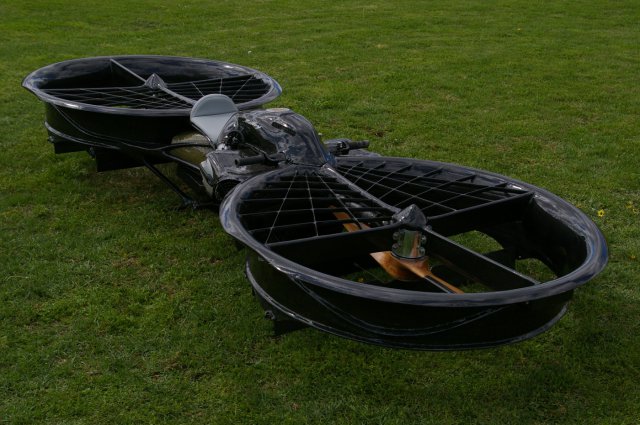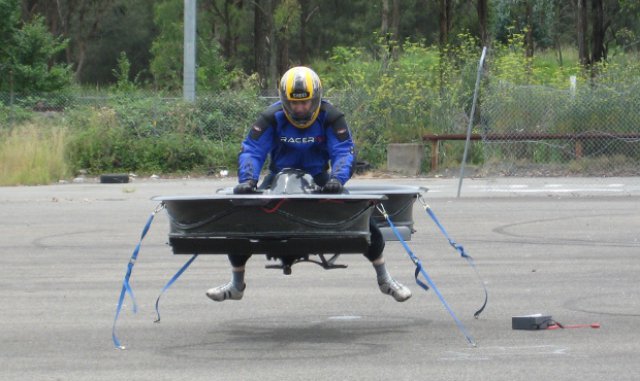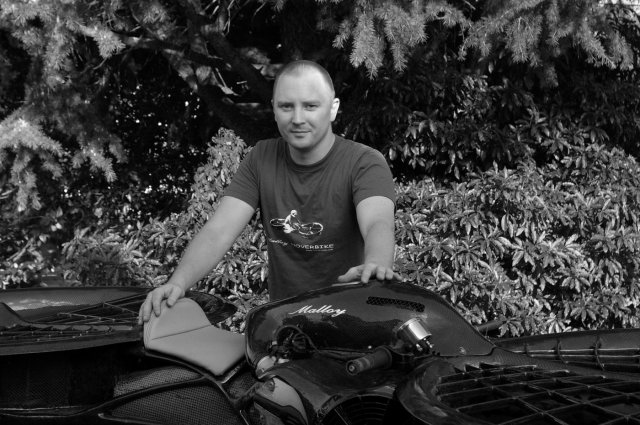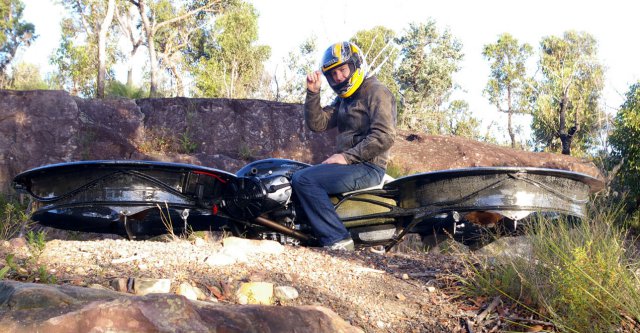 An Australian named Chris Malloy has built a Hoverbike from motorbike parts, which he claims can fly at 173mph at an altitude of 3,000 metres.
An Australian named Chris Malloy has built a Hoverbike from motorbike parts, which he claims can fly at 173mph at an altitude of 3,000 metres.
With a 1170 cc 4-stroke engine delivering 80 kW driving two ducted propellers, the inventor of the Hoverbike, Chris Malloy, says with its high thrust to weight ratio, the Hoverbike should be able to reach an estimated height of more than 10,000 feet and reach an indicated airspeed of 150 knots (278 km/h or 173 mph). At the moment these are only theoretical figures as the Hoverbike hasn’t been put through its paces yet, but Malloy has constructed a prototype Hoverbike and plans to conduct real world flight tests in a couple of months.
By day, Malloy works in the mechanical design of airborne and ground based hyper-spectral sensors at an optical engineering company in Australia. But after work and on weekends Malloy has spent the past two and a half years slaving away in his garage working on his Hoverbike. His efforts were prompted when his helicopter instructor likened a Robinson R22 light utility helicopter to an airborne motorbike. Disagreeing, Malloy set about building something closer to an actual flying motorbike.
The result is a prototype Hoverbike that seats a single pilot on a Kevlar reinforced carbon fiber with foam core frame in between two horizontal spinning propellers constructed from Tasmanian Oak with a carbon fiber leading edge. Instead of the complicated swash plate setup found in single rotor helicopters, the Hoverbike employs the same basic flying principles as a tandem-rotor Chinook helicopter. As with the Chinook, the counter-rotating rotors cancel out each other’s torque reaction, eliminating the need for an anti-torque vertical tail rotor and increasing the efficiency of the vehicle.
 Control of the Hoverbike is done completely via the handlebars. Forward and reverse movement is controlled via the motorbike-like handlebar grips. The right grip increases the thrust, while the left grip controls the angle of the control vanes positioned under the rotors to pitch the nose of the Hoverbike down – for forward movement – or up – for moving backwards. Meanwhile, turning is achieved by turning the handlebars left and right, just like a motorbike but with an extra axis that lets them rotate up and down a little, which alters the angle of the front and rear control vanes.
Control of the Hoverbike is done completely via the handlebars. Forward and reverse movement is controlled via the motorbike-like handlebar grips. The right grip increases the thrust, while the left grip controls the angle of the control vanes positioned under the rotors to pitch the nose of the Hoverbike down – for forward movement – or up – for moving backwards. Meanwhile, turning is achieved by turning the handlebars left and right, just like a motorbike but with an extra axis that lets them rotate up and down a little, which alters the angle of the front and rear control vanes.
With safety an obvious concern for airborne vehicles, Malloy says he has given as many components as possible triple redundancy and made the Hoverbike design as simple as possible. The current prototype doesn’t feature adjustable pitch propellers so it cannot autorotate in the case of an engine failure, but Malloy says the ability to add two explosive parachutes to the Hoverbike’s airfarme or have the rider wearing a parachute is a safer option.
 Malloy also says he plans to have the whole system controlled by gyros and he has already designed and partially tested the circuits and code required. But he initially wants to fine-tune the controls mechanically first to ensure he produces the most stable design. Eventually however, he says there will be room for a computer override of sorts to stop amateur pilots tipping over. The propellers, which are currently largely exposed, will also be fully covered in a mesh to ensure limbs don’t get too near the blades.
Malloy also says he plans to have the whole system controlled by gyros and he has already designed and partially tested the circuits and code required. But he initially wants to fine-tune the controls mechanically first to ensure he produces the most stable design. Eventually however, he says there will be room for a computer override of sorts to stop amateur pilots tipping over. The propellers, which are currently largely exposed, will also be fully covered in a mesh to ensure limbs don’t get too near the blades.
With dimensions of 3 m long by 1.3 m wide by 0.55 m high (9.8 x 4.3 x 1.8 ft), the Hoverbike weighs 105 kg (231 lb) and has a maximum takeoff weight of 270 kg 595 lb). Malloy claims the bike’s 30 L primary fuel tank should provide a range of 148 km (92 miles) at a cruising speed of 80 kts (148 km/h or 92 mph), while the addition of secondary fuel tanks that double the fuel capacity will double the range.
Malloy told Gizmag he expects his Hoverbike will have nearly the same abilities as a helicopter and it should outperform a two-blade aircraft such as a Robinson R22 acrobatically, however, due to the decreased rotor size its fuel consumption will be higher.
Although it sounds like it could be a lot of fun and would be a surefire way to beat traffic snarls, Malloy says he has designed the Hoverbike to be an airborne workhorse. Possible applications include aerial cattle mustering, search and rescue, aerial survey, film, power line inspection and military and emergency service.
In what should help with the obvious regulatory hurdles that will need to be crossed before it takes to the skies, in the U.S. the Hoverbike will be classed as an ultralite, which means that it will not require a pilot’s license to be flown.
Malloy hopes to be able to get the Hoverbike into limited production within a year, with full production possible another two years after that. He anticipates a production run of at least 100 units a year would see the price of the vehicle at around US$40,000, with the price coming down to around that of a performance motorcycle if he’s able to ramp up production to 1,000 units a year.
 Having invested much of his own time and money in getting the Hoverbike to its current prototype stage, Malloy says he is now looking for investors to enable him to push through the testing phase and get the vehicle into production – although he points out that any investment would need to see him retaining majority control of the company.
Having invested much of his own time and money in getting the Hoverbike to its current prototype stage, Malloy says he is now looking for investors to enable him to push through the testing phase and get the vehicle into production – although he points out that any investment would need to see him retaining majority control of the company.
Malloy says he’d also be happy to hear from any engineers with experience in computational fluid dynamics willing to volunteer their expertise to help model changes in the design and cut down on the amount of empirical testing.
To help generate interest in the hopes of attracting investors, Malloy plans to conduct flight tests in a couple of months. He has already conducted ground testing of the prototype with the bike remaining strapped to the ground, so the next stage of testing will be the first time the Hoverbike will actually fly untethered.
Source: Gizmag

hello my friend Mr. Chris Malloy,How are you today ? Saya amat berminat dengan ciptaan saudar a yang bernama ‘hoverbike’, juga saya memang menyukai bidang kejuruteraan terutamanya industri penerbangan, boleh saudara menghantar kepada saya beberapa maklumat berbentuk video @ risalah,gambar & sebagainya..! Email kan pada bila-bila masa, terima kasih.